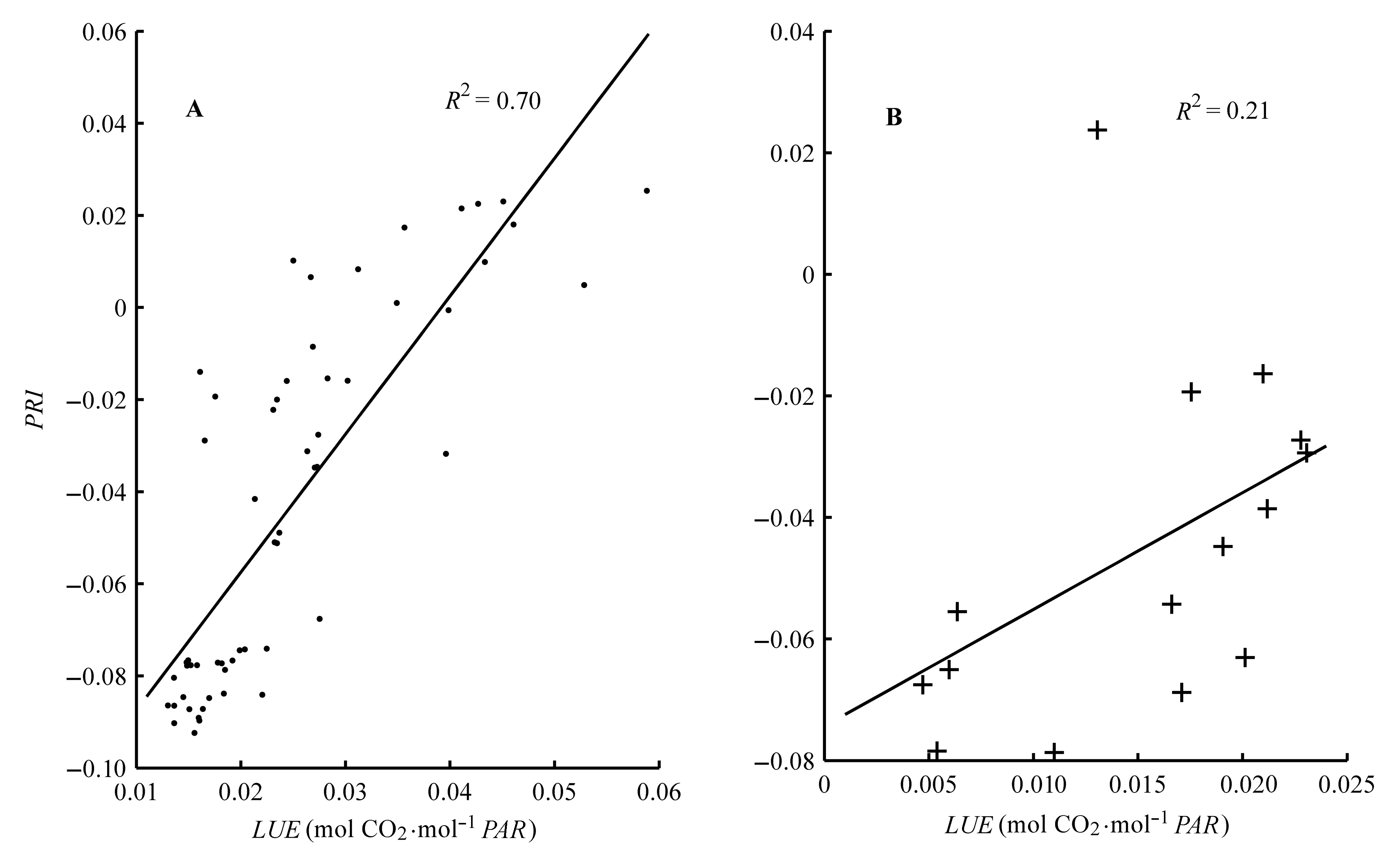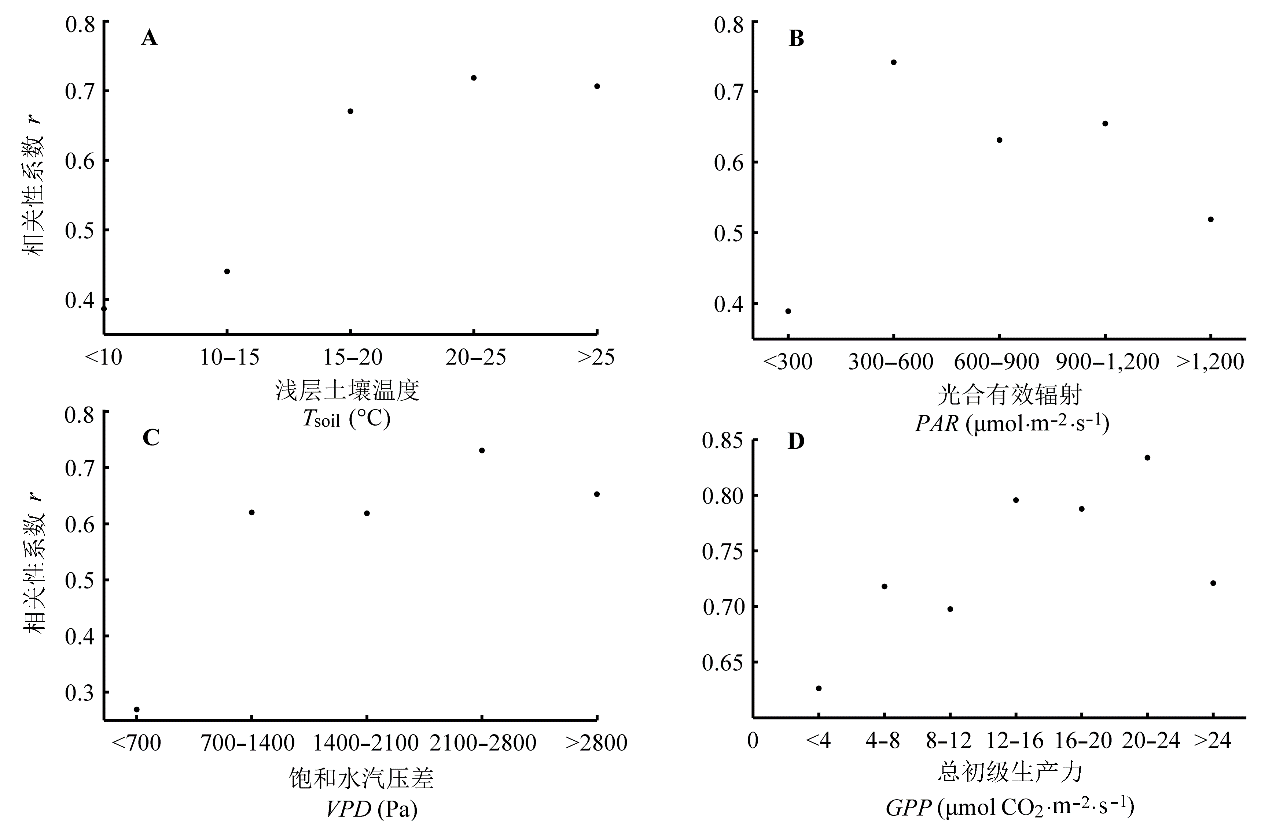

Chin J Plant Ecol ›› 2016, Vol. 40 ›› Issue (10): 1077-1089.DOI: 10.17521/cjpe.2015.0451
Special Issue: 生态遥感及应用
• Research Articles • Previous Articles Next Articles
Zhi-Qing YANG1, Bao-Zhang CHEN1,2,*( ), Tian-Shan ZHA1, Xin JIA1
), Tian-Shan ZHA1, Xin JIA1
Online:2016-10-10
Published:2016-11-02
Contact:
Bao-Zhang CHEN
Zhi-Qing YANG, Bao-Zhang CHEN, Tian-Shan ZHA, Xin JIA. Relationship between photochemical reflectance index with multi-angle hyper-spectrum and light use efficiency in urban green-land ecosystems[J]. Chin J Plant Ecol, 2016, 40(10): 1077-1089.
Add to citation manager EndNote|Ris|BibTeX
URL: https://www.plant-ecology.com/EN/10.17521/cjpe.2015.0451

Fig. 4 Variability of photochemical reflectance index (PRI) with different view angles. A, variability of PRI with different view azimuth angles (VAA) and view zenith angles (VZA). B, Illustrated PRI variations in relation to the angle between sun and viewer. Data obtained from 10:45 to 11:00 on August 31, 2012.

Fig. 5 Time variations of soil temperature (Tsoil), vapour pressure deficit (VPD), gross primary productivity (GPP), photosynthetically active radiation (PAR), photochemical reflectance index (PRI) and light use efficiency (LUE). PRI and LUE are measured every half hour from 9:00 to 16:00.

Fig. 6 Relationships of half-hour bioclimatic parameters (Tsoil, PAR and VPD) with light use efficiency (LUE) (A-C) and with photochemical reflectance index (PRI) (D-F) observed 9:00-16:00 each day across the autumn. PAR, photosynthetically active radiation; Tsoil, soil temperature; VPD, vapour pressure deficit.

Fig. 7 Correlation coefficients (r) of half-hour photochemical reflectance index (PRI) with light use efficiency (LUE) on individual days, with data acquired 9:00-16:00 (A) and half hour rainfall during the study period (B). The length of error-bars represents the p value of each linear regression. Positive indicate positive correlation, and negative indicate negative correlation in Fig. 7A.

Fig. 8 Relationships between half-hour (A) and daily (B) average photochemical reflectance index (PRI) and light use efficiency (LUE), calculated using data observed 9:00-16:00 each day throughout the study period.

Fig. 9 Linear relationships between daily average photochemical reflectance index (PRI) and light use efficiency (LUE), calculated using data observed 9:00-16:00 each day in the regular growth period (A) and leaf fall period (B).

Fig. 10 Average diurnal correlation coefficients (r) of half-hourly photochemical reflectance index (PRI) with light use efficiency (LUE) in relation to individual bioclimatic factors or gross primary productivity (GPP) throughout the whole season.
| [1] | Adamsen FG, Pinter PJ, Barnes EM, LaMorte RL, Wall GW, Leavitt SW, Kimball BA (1999). Measuring wheat senescence with a digital camera.Crop Science, 39, 719-724. |
| [2] | Barton C, North P (2001). Remote sensing of canopy light use efficiency using the photochemical reflectance index: Model and sensitivity analysis.Remote Sensing of Environment, 78, 264-273. |
| [3] | Chen WJ, Li CY, He GM, Wang XP, Zha TS, Jia X (2013). Dynamics of CO2 exchange and its environmental controls in an urban green-land ecosystem in Beijing Olympic Forest Park.Acta Ecologica Sinica, 33, 6712-6720.(in Chinese with English abstract)[陈文婧, 李春义, 何桂梅, 王小平, 查天山, 贾昕 (2013). 北京奥林匹克森林公园绿地碳交换动态及其环境控制因子. 生态学报, 33, 6712-6720.] |
| [4] | Filella I, Porcar-Castell A, Munné-Bosch S, Bäck J, Garbulsky M, Peñuelas J (2009). PRI assessment of long-term changes in carotenoids/chlorophyll ratio and short-term changes in de-epoxidation state of the xanthophyll cycle.International Journal of Remote Sensing, 30, 4443-4455. |
| [5] | Gamon J, Serrano L, Surfus J (1997). The photochemical reflectance index: An optical indicator of photosynthetic radiation use efficiency across species, functional types, and nutrient levels.Oecologia, 112, 492-501. |
| [6] | Gamon JA, Field CB, Bilger W, Bjǒrkman O, Fredeen AL, Peňuelas J (1990). Remote sensing of the xanthophyll cycle and chlorophyll fluorescence in sunflower leaves and canopies.Oecologia, 85, 1-7. |
| [7] | Gamon JA, Penuelas J, Field CB (1992). A narrow-waveband spectral index that tracks diurnal changes in photosynthetic efficiency.Remote Sensing of Environment, 41, 35-44. |
| [8] | Gu LH, Wilfred MP, Dennis DB, Andy BT, Shashi BV, Timo V, Steve CW (2003). Phenology of vegetation photosystem. In: Schwartz MD ed. Phenology: An Integrative Environmental Science. Springer, New York. |
| [9] | Hall FG, Hilker T, Coops NC (2011). PHOTOSYNSAT, photosynthesis from space: Theoretical foundations of a satellite concept and validation from tower and spaceborne data.Remote Sensing of Environment, 115, 1918-1925. |
| [10] | Hall FG, Hilker T, Coops NC (2012). Data assimilation of photosynthetic light-use efficiency using multi-angular satellite data: I. Model formulation.Remote Sensing of Environment, 121, 301-308. |
| [11] | Hall FG, Hilker T, Coops NC, Lyapustin A, Huemmrich KF, Middleton E, Margolis H, Drolet G, Black TA (2008). Multi-angle remote sensing of forest light use efficiency by observing PRI variation with canopy shadow fraction.Remote Sensing of Environment, 112, 3201-3211. |
| [12] | Hilker T, Coops NC, Hall FG, Black TA, Wulder MA, Nesic Z, Krishnan P (2008). Separating physiologically and directionally induced changes in PRI using BRDF models.Remote Sensing of Environment, 112, 2777-2788. |
| [13] | Hilker T, Gitelson A, Coops N, Hall F, Black T (2011). Tracking plant physiological properties from multi-angular tower-based remote sensing.Oecologia, 165, 865-876. |
| [14] | Hilker T, Hall FG, Tucker CJ, Coops NC, Black TA, Nichol CJ, Sellers PJ, Barr A, Hollinger DY, Munger JW (2012a). Data assimilation of photosynthetic light-use efficiency using multi-angular satellite data: II Model implementation and validation.Remote Sensing of Environment, 121, 287-300. |
| [15] | Hilker T, Lyapustin AI, Tucker CJ, Sellers PJ, Hall FG, Wang Y (2012b). Remote sensing of tropical ecosystems: Atmospheric correction and cloud masking matter.Remote Sensing of Environment, 127, 370-384. |
| [16] | Hu MM (2009).Preliminary Study on Plant Landscape and Eco-efficiency of Beijing Olympic Forest Park. Master degree dissertation, Beijing Forestry University, Beijing.(in Chinese).[胡淼淼 (2009). 北京奥林匹克森林公园植物景观与生态效益初探. 硕士学位论文, 北京林业大学, 北京.] |
| [17] | Lucht W, Schaaf CB, Strahler AH (2000). An algorithm for the retrieval of albedo from space using semiempirical BRDF models.IEEE Transactions on Geoscience and Remote Sensing, 38, 977-998. |
| [18] | Millward AA, Sabir S (2011). Benefits of a forested urban park: What is the value of Allan Gardens to the city of Toronto, Canada?Landscape and Urban Planning, 100(3), 177-188. |
| [19] | Nakaji T, Oguma H, Fujinuma Y (2006). Seasonal changes in the relationship between photochemical reflectance index and photosynthetic light use efficiency of Japanese larch needles.International Journal of Remote Sensing, 27, 493-509. |
| [20] | Nakaji T, Reiko I, Kentaro T, Yoshiko K, Shinjiro O, Kenlo NN, Nobuko S, Hiroyuki O (2008). Utility of spectral vegetation indices for estimation of light conversion efficiency in coniferous forests in Japan.Agricultural and Forest Meteorology, 148, 776-787. |
| [21] | Nichol CJ, Lloyd J, Shibistova O (2002). Remote sensing of photosynthetic-light-use efficiency of a Siberian boreal forest.Tellus, 54B, 677-687. |
| [22] | Nightingale JM, Coops NC, Waring RH, Hargrove WW (2007). Comparison of MODIS gross primary production estimates for forests across the U.S.A. with those generated by a simple process model, 3-PGS.Remote Sensing of Environment, 109, 500-509. |
| [23] | Peng T, Yao G, Gao HY, Li PM, Wang WW, Sun S, Zhao SJ (2009). Relationship between xanthophyll cycle and photochemical reflectance index measured at leaf or canopy level in two field-grown plant species. Acta Ecologica Sinica, 29, 1987-1993.(in Chinese with English abstract)[彭涛, 姚广, 高辉远, 李鹏民, 王未未, 孙山, 赵世杰 (2009). 植物叶片和冠层光化学反射指数与叶黄素循环的关系. 生态学报,29, 1987-1993.] |
| [24] | Penuelas J, Gamon JA, Griffin KL, Field CB (1993). Assessing community type, plant biomass, pigment composition, and photosynthetic efficiency of aquatic vegetation from spectral reflectance.Remote Sensing of Environment, 46, 110-118. |
| [25] | Penuelas J, Garbulsky MF, Gamon J, Inoue Y, Filella I (2011b). The photochemical reflectance index (PRI) and the remote sensing of leaf, canopy and ecosystem radiation use efficiencies: A review and meta-analysis.Remote Sensing of Environment, 115, 281-297. |
| [26] | Porcar-Castell A, Garcia-Plazaola JI, Nichol CJ, Kolari P, Olascoaga B, Kuusinen N, Fernández-Marín B, Pulkkinen M, Juurola E, Nikinmaa E (2012). Physiology of the seasonal relationship between the photochemical reflectance index and photosynthetic light use efficiency.Oecologia, 1-11. |
| [27] | Rahman A, Cordova V, Gamon J, Schmid H, Sims D (2004). Potential of MODIS ocean bands for estimating CO2 flux from terrestrial vegetation: A novel approach. Geophysical Research Letters, 31, L10503. |
| [28] | Richardson AD, Braswell BH, Hollinger DY, Jenkins JP, Ollinger SV (2009). Near-surface remote sensing of spatial and temporal variation in canopy phenology.Ecological Applications, 19, 1417-1428. |
| [29] | Richardson AD, Jenkins JP, Braswell BH, Hollinger DY, Ollinger SV, Smith ML (2007). Use of digital webcam images to track spring green-up in a deciduous broadleaf forest.Oecologia, 152, 323-334. |
| [30] | Wang LW, Wei YX (2015). A review on inversion of vegetation light use efficiency by hyper spectral remote sensing.Geomatics & Spatial Information Technology, 38(6), 15-22, 38.(in Chinese with English abstract)[王莉雯, 卫亚星 (2015). 植被光能利用率高光谱遥感反演研究进展. 测绘与空间地理信息,38(6), 15-22, 38.] |
| [31] | Wong CY, Gamon JA (2015). Three causes of variation in the photochemical reflectance index (PRI) in evergreen conifers.The New Phytologist, 206, 187-195. |
| [32] | Wu CY, Chen JM, Ankur RD, David YH, Altaf M, Hank AM, Christopher MG, Ralf MS (2012). Remote sensing of canopy light use efficiency in temperate and boreal forests of North America using MODIS imagery.Remote Sensing of Environment, 118, 60-72. |
| [33] | Wu CY, Niu Z, Tang Q, Huang WJ (2010). Revised photochemical reflectance index (PRI) for predicting light use efficiency of wheat in a growth cycle: Validation and comparison.International Journal of Remote Sensing, 311)2911-2924. |
| [34] | Zhou L, He HL, Zhang L, Sun XM, Shi PL, Ren XL, Yu GR (2012). Simulations of phenology in alpine grassland communities in Damxung, Xizang, based on digital camera images.Chinese Journal of Plant Ecology, 36, 1125-1135.(in Chinese with English abstract)[周磊, 何洪林, 张黎, 孙晓敏, 石培礼, 任小丽, 于贵瑞 (2012). 基于数字相机图像的西藏当雄高寒草地群落物候模拟. 植物生态学报,36, 1125-1135.] |
| [1] | LI Xin-Hao, YAN Hui-Juan, WEI Teng-Zhou, ZHOU Wen-Jun, JIA Xin, ZHA Tian-Shan. Relative changes of resource use efficiencies and their responses to environmental factors in Artemisia ordosica during growing season [J]. Chin J Plant Ecol, 2019, 43(10): 889-898. |
| [2] | ZHANG Lei-Ming,CAO Pei-Yu,ZHU Ya-Ping,LI Qing-Kang,ZHANG Jun-Hui,WANG Xiao-Ling,DAI Guan-Hua,LI Jin-Gong. Dynamics and regulations of ecosystem light use efficiency in a broad-leaved Korean pine mixed forest, Changbai Mountain [J]. Chin J Plan Ecolo, 2015, 39(12): 1156-1165. |
| [3] | ZHOU Lei, HE Hong-Lin, ZHANG Li, SUN Xiao-Min, SHI Pei-Li, REN Xiao-Li, YU Gui-Rui. Simulations of phenology in alpine grassland communities in Damxung, Xizang, based on digital camera images [J]. Chin J Plant Ecol, 2012, 36(11): 1125-1135. |
| [4] | YU Ying, FAN Wen-Yi, YANG Xi-Guang. Comparisons of three models for vegetation canopy bi-directional reflectance distribution function [J]. Chin J Plant Ecol, 2012, 36(1): 55-62. |
| [5] | WU Chao-Yang, NIU Zheng. REVIEW OF RETRIEVAL LIGHT USE EFFICIENCY USING PHOTOCHEMICAL REFLECTANCE INDEX (PRI) [J]. Chin J Plant Ecol, 2008, 32(3): 734-740. |
| [6] | CUI Xiao-Yong, Du Zhan-Chi, Wang Yan-Fen. Photosynthetic Characteristics of a Semi-arid Sandy Grassland Community in Inner Mongolia [J]. Chin J Plan Ecolo, 2000, 24(5): 541-546. |
| Viewed | ||||||
|
Full text |
|
|||||
|
Abstract |
|
|||||
Copyright © 2022 Chinese Journal of Plant Ecology
Tel: 010-62836134, 62836138, E-mail: apes@ibcas.ac.cn, cjpe@ibcas.ac.cn